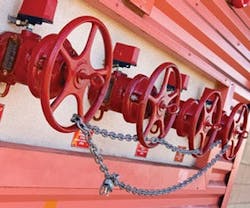With major initiatives competing for your attention, the state of your sprinklers is probably low on your priority list. But let your maintenance and inspection routine become lax and you could be compromising your life safety with every passing minute.
“With so many businesses on life support trying to survive, the last thing an owner wants to do is spend $300 getting the sprinklers tested – it’s another cost that has to be absorbed,” says Bernie Arends, an inspection, testing, and maintenance specialist for the National Fire Sprinkler Association. “But if there’s a fire, chances are the business will close.”
To keep your fire protection system on your radar, follow the recommendations as specified in NFPA 25. This standard provides guidance for the inspection, testing, and maintenance of fire protection systems, from fixed water spray, mist, and foam versions to standpipes and hoses.
High Stakes
Apart from the obvious ramifications to a property and its occupants, dilapidated sprinklers could negate your insurance coverage – it’s built on the premise that you have proper systems in place and are testing them.
“I know of a facility that had a problem with its sprinklers and settled with the insurance company to fix it, but they were never repaired,” Arends recalls. “When a massive fire destroyed the building, the insurance company denied the claim.”
Failing to update your inspection records with your insurance provider can also dramatically reduce your coverage. Without notification that your required annual inspection has been completed, your insurance company can drop your coverage by up to 30% for the first year and 60% the second, Arends explains.
After three years, insurance could be canceled altogether. Remember it’s your job, not the inspector’s, to update records with the insurance company.
“Even if NFPA 25 isn’t adopted into regulation in your jurisdiction, it is considered a standard of care,” adds Chris Jelenewicz, an engineering program manager for the Society of Fire Protection Engineers. “If you ever had a huge fire and there were life safety implications, you can show your inspection and testing reports to prove your system wasn’t defective.”
Common Obstructions
The good news is that most deficiencies in fire protection systems can be prevented with routine maintenance or easily spotted during an inspection.
Prioritize Your Problems
Do you have 24 hours or 30 days to fix a sprinkler deficiency?
- Impairment (24 hours) – faulty controllers, stuck or slow-responding valves, blocked anti-vortex plate, non-operational pressure switch, substantial differences between pressure readings and original design requirements, a pump won’t start automatically
- Critical and Noncritical (30 days) – automatic drains not free or open, damaged or plugged strainer, missing or loose detectors, incorrect water or air pressure levels, failed or incorrectly reading pressure gauge, missing protection cap on fire department connections
Common issues to look for are a blocked water supply or changes in occupancy or modifications to the space that can render coverage useless.
Microbiologically influenced corrosion, or MIC, is a frequent culprit, but is easy to find and treat if you’re looking for it. Closed valves, however, are tough to spot without inspections, adds Jelenewicz. You may not notice the drop in pressure because a partially closed valve can still provide enough water for day-to-day needs.
If you find impairments during routine maintenance or inspection, it’s best to prioritize the order of repairs. A matrix based on NFPA 25 guidelines and developed by the Florida Fire Sprinkler Association helps determine whether you should fix a deficiency within 24 hours or 30 days.
A clogged drain may not seem like a pressing problem, but remember that each component of your fire protection system is dependent on the others.
“From sprinklers and fire alarms to smoke management and exiting systems, you need to have a holistic approach,” recommends Jelenewicz. “They’re all working together and if you don’t have one part of the system working, it will influence the others.”
Jennie Morton ([email protected]) is assistant editor of BUILDINGS.
About the Author
Jennie Morton
A former BUILDINGS editor, Jennie Morton is a freelance writer specializing in commercial architecture, IoT and proptech.
